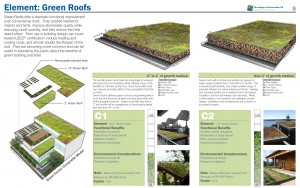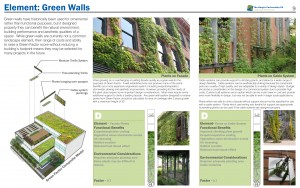
Functional Landscapes: Assessing Elements of Seattle Green Factor
The 2010 WASLA awards were recently announced and winning a Merit Award for Research and Communication was a report by The Berger Partnership titled Functiontal Landscapes – Assessing Elements of Seattle’s Green Factor (PDF). The report graphically shows the benefits of the Green Factor program with in-depth looks at each category. The report is well done and the graphic elements explain the program better than the City of Seattle’s Green Factor website does. Here is a brief description of the Green Factor from the City of Seattle website:
The Green Factor is a landscape requirement designed to increase the quantity and quality of planted areas in Seattle while allowing flexibility for developers and designers to meet development standards. It currently applies to new development in commercial and neighborhood commercial zones outside of downtown, and is proposed for multifamily residential zones and the South Downtown planning area.
For each element in the report, functional benefits are highlighted including air cleansing, reduced heat island, reduced stormwater runoff, education and habitat creation. Habitat creation actually occurs on a number of the elements including planted areas, trees, green roofs, green walls and native plants. However, as a whole, the program can combine other elements such as deeper soils and water features to benefit habitat as well. Water features can provide water for drinking as well as bathing for birds and a regular supply could potentially provide habitat for dragonflies. Deeper soils benefit wildlife directly and indirectly by improving the diversity of life in soils which provide direct food for foraging birds and some mammals. Indirectly, deeper soils provide more nutrients and space for better plant growth which will benefit wildlife as well.
However, implying that these elements provide habitat is an incomplete picture because, while individually they have the potential to provide habitat, if they’re not designed with habitat in mind then they could turn out to be sterile and not provide any wildlife benefit at all. Green does not equal habitat. In fact if you look at the suggested plant lists (PDF), at a quick glance it looks like less than half the plants are natives and there are no notes whether or not they provide any direct benefit to wildlife. While it’s not necessary to plant exclusively with natives and other plants do offer benefits as well, local wildlife have evolved with the local plants. There are many great plant lists that can be drawn from including the book Landscaping with Wildlife in the Pacific Northwest, websites like the Washington Butterfly Society and Washington Native Plant Society, or check out any of the links under Native Plants, Pollinator Design or Butterfly Design on the right hand side of this blog.

Functional Landscapes: Assessing Elements of Seattle Green Factor
There are also suggestions in the maintenance plan (no longer available online) that do not benefit wildlife such as raking leaves and removing all dead tree materials, both of which provide an abundance of habitat. There is a recommendation to use Integrated Pest Management, but no requirement and as we all know, pesticides can be a make-or-break deal for wildlife. The subject of maintenance with regular pruning, removing weeds, cleaning up plant debris highlights one of the big problems with urban habitat. Most often habitat is messy, dead wood, plant debris on the ground and even weeds provide a considerable amount of habitat for everything from birds, to insects to bats. In neighborhoods or urban settings messy isn’t usually acceptable, hence the rigorous maintenance plan. How do we bring the two together? So far the best results have come from education about habitat partnered with an attempt to keep the ‘messy’ somewhat organized. I think this piece is the key to providing successful urban wildlife habitat.
As for the Green Factor, it has some great potential but unfortunately lacks the information to make successful habitat. Just saying it can provide habitat is not good enough. It’s too bad habitat doesn’t get the attention it deserves. There’s another program that completely misses the mark as well, which I’ll be posting about soon. It is also a shame that this plan excludes downtown and that they haven’t created another plan, or modified this one, for downtown.
Visit the City of Seattle’s Green Factor page.
Read the assessment report: Functiontal Landscapes – Assessing Elements of Seattle’s Green Factor (PDF)





